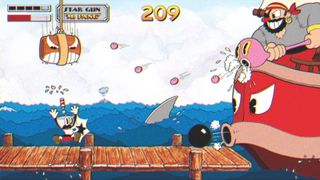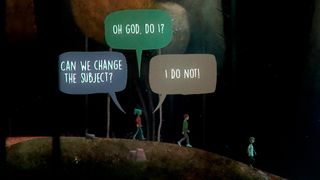With the ID@Xbox program helping its 500th indie game into the store, we ask about what comes next

This interview was conducted by Xbox: The Official Magazine
The indie game has come a long way since Xbox Live first launched, from tiny games that only a few had heard of to breakout success stories that rival even the biggest mainstream games. You don’t need a team of hundreds to make a great game. Enter ID@Xbox, a programme that helps hundreds of small-scale developers get their games on Xbox One and in front of an audience of millions for everyone to enjoy. We speak to Chris Charla, the man responsible for bringing the likes of Inside, Oxenfree and soon Cuphead to your console, to learn what’s in store for fans of indie gaming.

OXM: The ID@Xbox program has grown hugely since it launched. What do you see as its biggest successes, and success stories?
Chris Charla: It’s been awesome to see the program grow since we announced it in 2013. We hit 500 games that have shipped via the program by the end of April, and that’s kind of a cool milestone! When we started the program we said we wanted to provide developers with a sustainable ecosystem and marketplace, and thanks to our players, we’ve really done that. Obviously, videogames are a hit-driven business, and not every game is a hit, but developers have made hundreds of millions of dollars through ID and it feels awesome to be a little part of that. It also means players have bought millions of ID games, and they’re getting to enjoy all this diverse content. So, successful devs and happy players is definitely the biggest success!
Of course, commercial success is really important, too, but there’s a lot of kinds of success – critical, personal, creative. And there have been some great success stories in the program that aren’t just commercial, where a dev has said “I had this idea, and I was able to ship it on Xbox, and that means a huge amount to me,” and that’s equally as awesome as some of the commercial successes we’ve seen.
I will say internally, of course we celebrate developers’ success, but when we think about the program, it’s more about how we can improve on what we’ve done, or new things we can offer, versus high-fiving and saying “we did it!” or something. There’s a lot more we can do for developers, so that’s kind of our focus, day to day.

OXM: Are there any developers that you think epitomise ID@Xbox, and the ideals that you at Microsoft have for the program?
Sign up to the GamesRadar+ Newsletter
Weekly digests, tales from the communities you love, and more
CC: Hmmm... One thing we kind of got right with ID, is we didn’t say, “Okay, it’s 2013, this game is what ‘indie games’ are, and how do we solve for that,” but instead we looked at the space and saw the growth, saw how much things had changed during the 360 era, and we knew things would happen that we couldn’t predict. So, we really took a developer’s eye view and tried to build a program that was going to meet the needs of independent developers on Xbox and Windows, regardless of game type, or company type, or how the industry might change. And that’s given us the flexibility in the program to support devs of all sizes, and games of all sizes and complexity, from single-player platformers made by one person to free-to-play online games made by very large independent studios.
And one thing I’m really proud of with ID@ Xbox is we’ve had devs ship their first game, and we’ve had really veteran studios and developers ship. So, in a sense, everyone in the program kind of epitomises who the program is for. Which may sound like a dodge, but it’s really true.
That all said, there are a couple of developers who in 2012 and 2013 we were like, “these guys should be on Xbox, and they’re not – and that is a problem.” That was the kind of early model for what we should do with ID@Xbox – how could we create a program that would enable them to come to Xbox and be successful. I’m not going to name them – sorry! – but they do know who they are. And they’re on Xbox now!

OXM: Okay, so let’s take a look forward and look to the future. Which ID@Xbox games are you most excited about in 2017?
CC: Yes. [laughs] I’m sorry it’s a really hard question to answer. Because I have games I’m just excited for as a player, I have games I’m excited about for maybe a business reason or program reason, like, “I know how much work we needed to do to help the game come to Xbox or Windows 10,” or games that are coming from devs from a new territory – we just had our first game pass cert that was developed in Africa – or maybe a game uses an Xbox Live feature like Arena in some cool way. So, I get excited about a lot of games for a lot of reasons. Personally, as a player, I am really looking forward to Below, Tacoma and Cuphead!

OXM: Out of the ID@Xbox games you’ve played recently, which would you say have really stood out for you?
CC: Thimbleweed Park has been really fun – there’s so much content in the game, and I love adventure games. And it’s cool seeing my friends’ names in the game – they were Kickstarter backers! And I’m still having a lot of fun with Astroneer and Ark. This weekend I played a lot of Snake Pass too, which is super original and super challenging (and satisfying!). I end up playing a lot of games a little bit just to try to and play everything.
OXM: How do you find new games to bring to ID@ Xbox? Do developers come to you, or do you go to them?
CC: Both of those things happen. Lots and lots of developers join the program and submit games, and that’s how we learn about them, and we also do a lot of outreach at shows like GDC, PAX and others, online, and at small dev events we have. We are always on the hunt for cool games!

OXM: How much do you think people are using cross play to play against players on PCs or other Windows 10 devices? Are many indie developers adding it to their games?
CC: Cross play is a feature we’re really excited to support, and if you look at a title like Rocket League that supports cross-network play with PC versions of the game, it’s really popular. For us, Xbox Live and everything we do on Xbox is all about enabling play and enabling players. So, from the perspective of Xbox Play Anywhere – which means that once you buy a game on Windows 10 or Xbox, you own it for both platforms to cross play on Xbox Live between Windows and Xbox – it’s something we’re excited to support. We’ve seen some good take up across all those initiatives, although the bulk of games that ship through ID are single-player, so it’s not always possible to support all those features.

OXM: Next we’d like to talk about the Creator’s Program, which you announced for smaller developers to bring games to Xbox. When it was announced, ID@Xbox was designed to be a way to make it easy for indie developers to make games. If that’s the case, why do you need the Creator’s Program?
CC: Looking at both paths, we want to give developers more choice in how they bring their games to Xbox Live. From the start, ID@Xbox was designed for professional game developers who wish to use the full Xbox Live stack and have additional marketing and development support, including access to Xbox One and Project Scorpio development kits. Games that come through ID@Xbox get access to everything any other game can do on Xbox, whether that’s platform features or store promotion features. On the flip side, they still require full certification and full Xbox Live implementation to work.
The Creators Program is great because it allows developers to quickly publish their game to Xbox One and Windows 10, with a simplified certification process. And you can integrate Xbox Live social features into your game with minimal development time. The Creators Program is for everyone, from professional developers to educators, students, hobbyists, experimenters, and makers of all shapes and sizes.
“Developers have sold millions of games through ID and it’s awesome to be a small part of that”
Chris Charla
All the way back in 2013, we were very clear that any Xbox would be able to be a dev kit, and that we wanted Xbox One to be something that was as good for creating as it was for enjoying games. This is why we opened up Xbox One to Universal Windows Platform (UWP) development last year with the release of the free Dev Mode Activation app. And we also opened up our app store on Xbox One to all app developers.
With the Creators Program, we have now opened the store on Xbox One to all game developers. This is just another option for developers – a lightweight, fully public way to ship a game on Windows 10 and Xbox One. I think it’s a great compliment to ID@Xbox and one that enables Microsoft to offer the broadest array of options to potential developers, from large corporations that manufacture millions of discs, to indie developers who focus on digital distribution, to folks who turn their retail Xbox One to a dev kit and just start creating.

OXM: What sort of games do you expect to see from the Creator’s Program? Is there a variety of games you’d like to see?
CC: I think we’ll see a huge variety of stuff. We’ll see things that don’t quite fit the traditional definition of “game”. We’ll see hobbyist and professional projects... we’ll see a lot! I think one thing that is true of every platform is if you build a space that makes it easy for people to ship games, you see a lot of stuff! What I’m most excited to see is something I can’t even conceive of right now – and I really think Creators Program has a good chance to be a super fertile place for new talent to show their stuff on Xbox.
OXM: Is this an ‘in-route’ for developers to prepare them for making a full ID@Xbox game, or are the two things aimed at different kinds of developer?
CC: One really key thing about ID@Xbox, and Creators Program, is that they are game-based programs, not developer-based. So, I’d say it’s a thing that will probably be decided on a game-by-game basis. You may have a developer who starts out, maybe she’s in school, and she has a cool student project, and it comes out via Creators Program, but her next game comes via ID.
And you may have a long-standing ID dev who makes a game and wants it out there quickly and just ships it via Creators. From a developer point of view, what we want to do is make sure that regardless of where a developer is in their journey, or regardless of how they want to handle their game, that we have a place for them in our ecosystem, from hobbyists and experimenters, to moonlighters and rookies, to professionals and veterans. That ensures we’re going to get a huge variety of games on our platform, which is great for our players and helps build just a great ecosystem for both players and creators to thrive.

OXM: Steam’s Greenlight program suffered from a ‘bloatware’ problem. Do you foresee this being a problem with the Creator’s Program? Do you have a way of curating what appears in the Creator’s Program Store?
CC: I’ll handle these two as one question if that’s okay! I can’t really comment on Steam, but if you’re asking about marketplaces, it’s a great question, and one we’ve thought about a lot. When you think of traditional retail shopping, humanity has had about 10,000 years to perfect things. On the digital front, we’re really only 10 or 15 years in, so we’re still learning a lot. Both curated and open marketplaces have advantages. Curation works to make discovery and surfacing things easier, but you run the risk that the curators miss something. Uncurated marketplaces don’t have that risk, but they run the risk – or the certainty – of having lots of noise-to-signal because there’s no one really policing things.
“I feel excited because Creators Program could be a super fertile place for talent to show their stuff on Xbox”
Chris Charla
With Xbox Live Creators Program we thought about this a lot. And I think the solution Microsoft came up with is actually really interesting. So, on our PC store, all games are assorted together today, whether they have Xbox Live integration or not, so we’ll keep doing that with Creators Program games – they’ll be assorted with every other game. On console, though, players and parents expect a curated store experience. So, we’re maintaining that store experience for them, and we’re putting the open, uncurated Creators Program games in their own section. We’re sort of saying, “here’s our curated store, and here’s our uncurated section.” It may seem less elegant than solving the curation/discovery problem all up, but I actually think it will give us the best of both worlds, and address our desire to make sure Xbox is truly an open platform, while keeping the curation that our players expect and like in the store.
And we will definitely have programmatic promotion in the Creators Program section of the store, with things such as collections for new releases, top rated, et cetera. So players will be able to see what’s popular.

OXM: Could a game move out of the Creator’s Program into ID@Xbox, or into the main Store if it was doing well?
CC: Absolutely. It could move from Creators to ID@Xbox before it even releases. There are a couple of back-end things we need to address to make this happen on the tech side, so let me put an asterisk there and say “Absolutely... later this summer,” but directionally, philosophically, absolutely! We expect to see lots of ID submission that have already started development and Live implementation via Creators, and we expect to see plenty of games launch in the Creators Program and then hopefully come through ID@Xbox later on.
This article originally appeared in Xbox: The Official Magazine. For more great Xbox coverage, you can subscribe here.
Stephen is the former Editor of The Official Xbox Magazine, and contributor to publications including GamesRadar. Since leaving Future PLC, Stephen has been a copywriter, and is now Head of Content for collaboration tool, Sketch.
Most Popular




